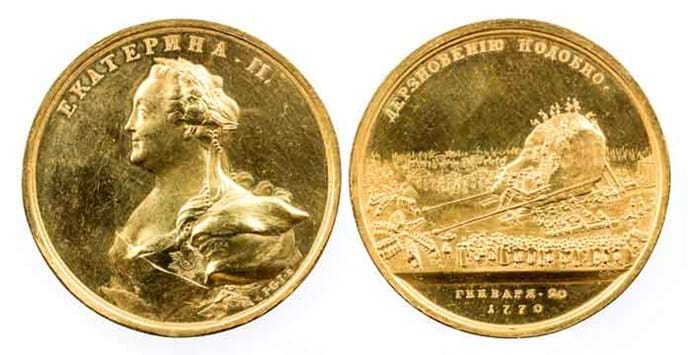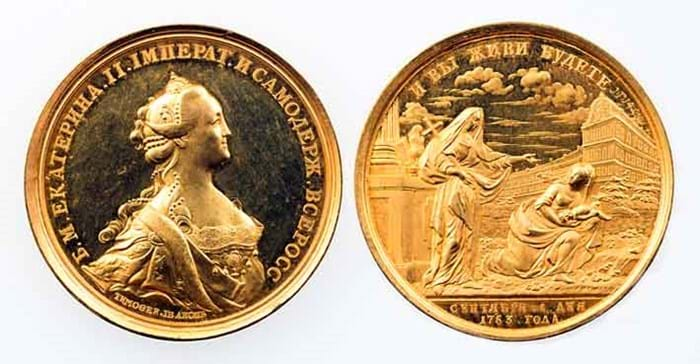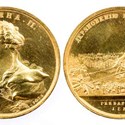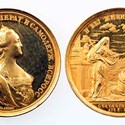Pre-sale publicity that the medals had been "found during a house clearance in Dorset" undercooked the weight of their provenance.
Family heirlooms of the Battens of Church Farm, Ryme Intrinseca near Sherborne, they are thought to have once been the property of John Chamberlaine (1745-1812), an antiquary who held the position of keeper of drawings, coins and medals to King George III from 1791. Empress Catherine may have given them to him herself.
Thunder Stone
The larger of the two medals at 2½in (6.5cm) depicts the laureate bust of Catherine II together with the signature of the engraver JCC Jaeger to the obverse. Verso is a panoramic view of the transport of the massive granite monolith used as a pedestal for the monument to Peter the Great together with the date of 1770.
The block, known as The Thunder Stone, had a calculated weight of 15,000 tonnes and is considered the largest stone ever moved by man. No animals or machines were used as - under the aegis of the Greek engineer and Russian army officer Marinos Carburis (1729-82) - it made its way 6km overland from a forest near the village of Konnaya Lakhta to the Gulf of Finland and then by barge to St Petersburg.
The scene depicted on the medal, complete with Tsarina, workers and crowds of spectators, comes from a famous engraving, The Transportation of the Thunder-stone in the Presence of Catherine II, based on drawings by the court architect, Yury Matveyevich Felten (1730-1801).
Foundling Medal
The other medal, measuring 2in (5cm), commemorates the establishment of the foundling home in Moscow on September 1, 1763. The half-length portrait of Catherine II is inscribed (in Russian) By the Grace of God Catherine II Empress and Autocrat of All Russia, and marked for the engraver Timothei Ivanovich Ivanov (1729-1802/3).
To the reverse, titled Ye Shall Live Also, is a view of the Moscow foundling home accompanied by the personification of Faith holding a cross beside a mother and her baby.
The signature to a column JG Waechter f is for the German medallist Johan Georg Wächter (1726-1800).
Ivan Ivanovich Betskoy (1703-95), the school reformer who served as Catherine the Great's advisor on education and oversaw the creation of foundling homes in Moscow and St Petersburg, documented the production of this medal. He wrote that the Tsarina "was presented with five golden, two silver and six bronze medals and her son Pavel Petrovich received one of each kind".
The last gold example to appear on the market appeared at Bonhams in November 2005 when it sold at £20,000. It had a later loop mount.
Duke's medals, estimated at £3000-6000 each at the sale on March 12, were in outstanding condition, showing only minimal wear - the Thunder Stone medal offered in its original turned wood box. They generated huge interest among a Russian collecting audience enthralled by trophies of the Tsarist era. The foundling home medal was the first to sell at £70,000, the Thunder Stone following at £80,000.
The buyer's premium was 22%.









